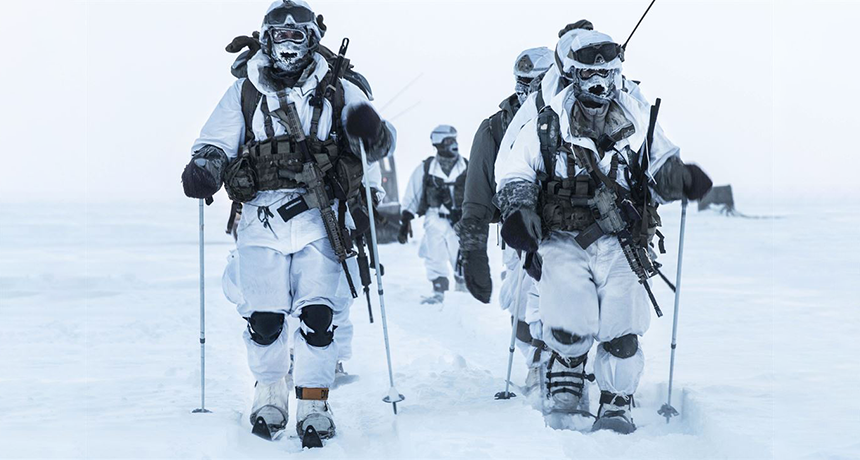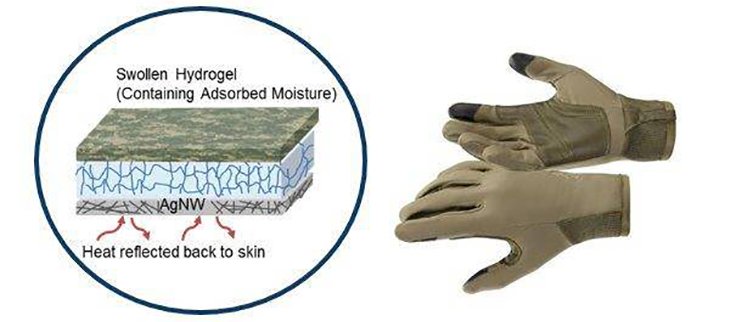U.S. Army is developing high-tech underwear
Nanowires and moisture-slurping beads should keep soldiers warm and dry in super-frigid environments

Army officers Ethan Diven and Evan Lewandowski soldier through frigid winter weather toward a pickup point after a successful training exercise at Deadhorse, Alaska in February 2017.
Staff Sgt Daniel Love, U.S. Army
WASHINGTON, D.C. — Soldiers can’t achieve peak performance when they’re chilled to the bone. So in winter weather, some soldiers may don up to seven layers of clothing. That much fabric can weigh them down. Later, soldiers might find themselves overdressed, now getting hot and sweaty. That sweat, in turn, can turn to ice if the weather is super cold. But it doesn’t have to. Researchers have just come up with a way to lighten a winter warrior’s load and fight the threat of frozen sweat.
They’ve designed a new high-performance fabric. It could become the basis of underwear for troops deployed in places blasted by Arctic cold. Scientists unveiled it here, last August, at the fall meeting of the American Chemical Society.
Paola D’Angelo is a bioengineer. She uses principles of biology to solve problems. Elizabeth Hirst is a chemist. Both work at the U.S. Army Natick Soldier Research, Development and Engineering Center in Massachusetts. Their team got the initial idea for this innovation from some earlier work by a group at Stanford University in California. Their new fabric improves on that earlier research. It also adds an important new twist.
Hot stuff
Yi Cui and Po-Chun Hsu are materials scientists at Stanford University. Their team already had been using metal nanowires to create see-through electrical conductors. Such materials could be handy for things such as thinner smartphones, displays on car windshields and more. Teeny, tiny nanowires have diameters at the scale of billionths of a meter.
At Cui’s suggestion, the Stanford team set out to use conductive nanowires in a fabric. It would be “warm, lightweight and breathable,” explains Hsu. That way, it could help reduce the energy needed for indoor heating.
The team got itty bitty wires of silver to form a mesh across cotton fabric. The silvery metal can reflect body heat back to someone’s skin. The treated fabric also can carry an electrical current. So, batteries could deliver extra heat when needed. Cui’s team described its work two years ago in Nano Letters.
Now the Army’s team has been tweaking that idea to work not just with cotton, but also with high-performance fabrics. Athletes, soldiers and others often turn to such fabrics when they’re doing things that call for lots of physical activity or that expose them to extreme conditions.
Examples of these special fabrics include polyester, nylon and other synthetic fabrics. Their fibers are engineered by people, instead of coming from natural materials, such as plant fibers or animal hair. The Army uses synthetic fabrics (or blends that include synthetics) for gloves, socks and a soldier’s base layer. That’s the “underwear” that sits closest to the skin. And it’s for that layer that this team has been building upon the Stanford group’s work.
Besides getting the concept to work with other fabrics, the Army researchers tested the ability of such fabrics to hold up through repeated washings. And their fabric indeed performed well.
In addition, the Army team packed more fibers onto each area of fabric than the Stanford team had. That denser wire mesh can carry more current and provide more warmth. Three volts of electricity is enough to warm a test swatch that’s 6.45 square centimeters (1-square-inch) in one minute by 56 degrees Celsius (100 degrees Fahrenheit), D’Angelo reports. A typical watch battery is all that’s needed to provide those 3 volts.
Soldiers won’t want their underwear that hot. But the fabric could provide quick heat in a hurry. With the right controls, soldiers could even customize how warm their clothes get.
Super soakers for sweat
That material would still not be a perfect solution for working in cold weather, however. Even if it were used under with the Army’s current winter wear, soldiers can get sweaty as they hike, climb or carry out other tasks. That’s because the synthetic fabric of the base layer is not good at wicking away moisture, Hirst explains. Instead, sweat soaks into the fabric. As water in the sweat cools, it can ice up. That’s “obviously very uncomfortable,” she adds.
To deal with this, her team is working with hydrogel beads. A hydrogel is a type of “super soaker” material that can absorb a lot of water. In this case, the beads can sop up as much as 40 times their weight in water, Hirst says. The molecules of the beads are made from polymers. These are long chains of identical repeating units. A part of each unit in the hydrogel has a segment that attracts water.
Researchers could tweak the hydrogel to act differently at different temperatures, Hirst points out. As a soldier sweats, the fabric would warm. That warming could lead the hydrogel to soak up any sweat, moving moisture away from the skin. Later, when the soldier took off the underwear, it would cool down. Moisture in the hydrogel beads could then evaporate into the air. Now the fabric would be ready to wear again.
Don’t expect to see the new fabric on soldiers just yet. “We are in the basic research stages,” Hirst says. Among other things, her team will play with different ways to attach the hydrogel beads to the wired fabric. Her group also wants to work on a protective coating for the nanowires. That would help the silver resist tarnishing, which could reduce its reflectiveness.
Story continues below image.

“We look forward to seeing their cloth combining silver nanowire and hydrogel together,” says Hsu. In his view, it makes good sense to combine features that would provide both heating and cooling as needed. “In the future stages of this research,” he suspects, “there might be some trade-off between the total amount of heating and cooling that the cloth can provide versus its compactness and weight.”
In addition to developing better winter underwear, the Army team hopes the new fabric might lead to warmer gloves and socks. After lots and lots of field testing by soldiers, the fabric might find its way into civilian clothes, too. Then anyone could wear it for skiing, winter walks, snowboarding or other cold-weather fun.
The outdoor temperature topped 32º C (90º F) when the researchers unveiled their new fabric in Washington, D.C. Few folks at the meeting were ready for winter. Later, however, many might appreciate that some scientists and engineers had been thinking ahead.
This is one in a series presenting news on technology and innovation, made possible with generous support from the Lemelson Foundation.







